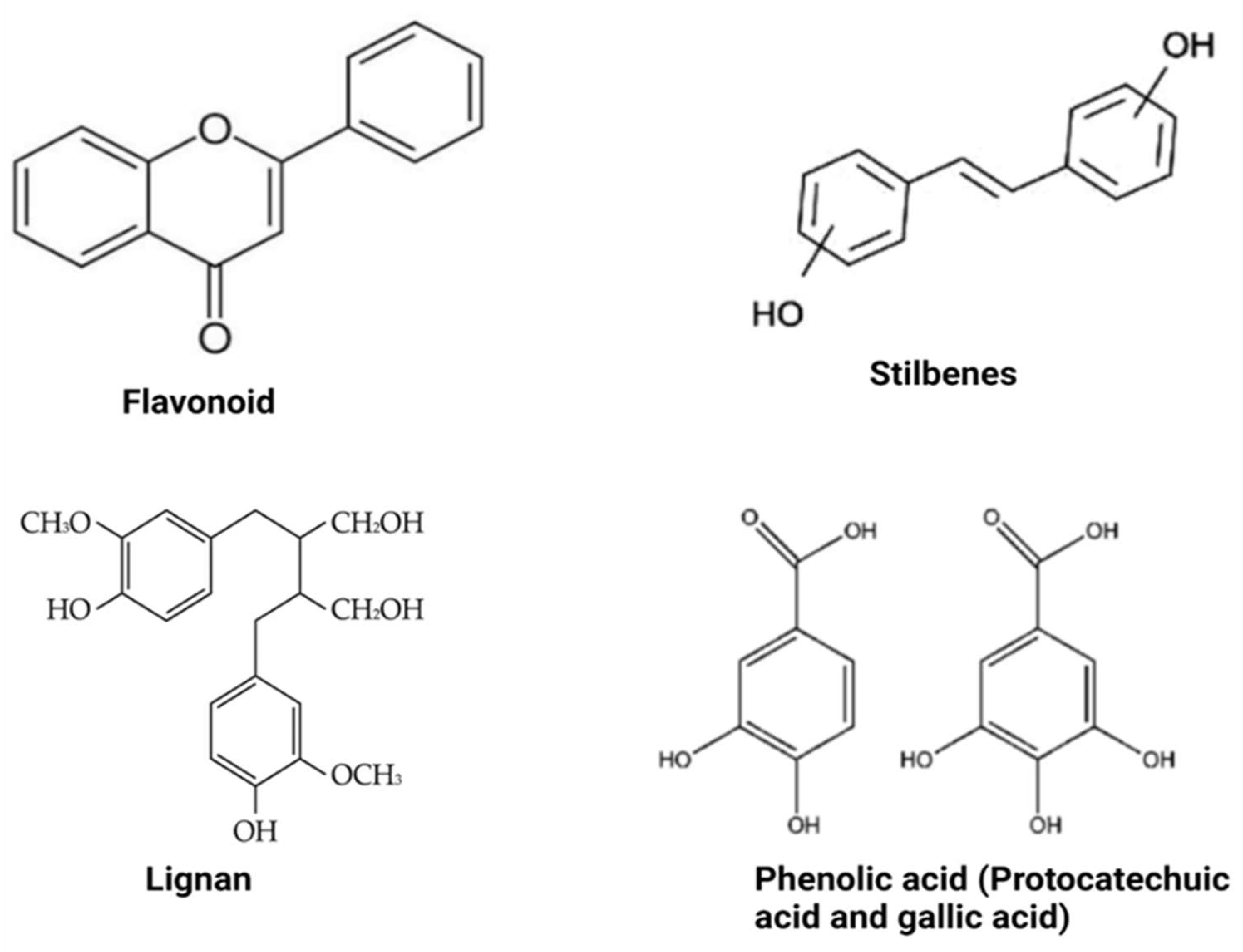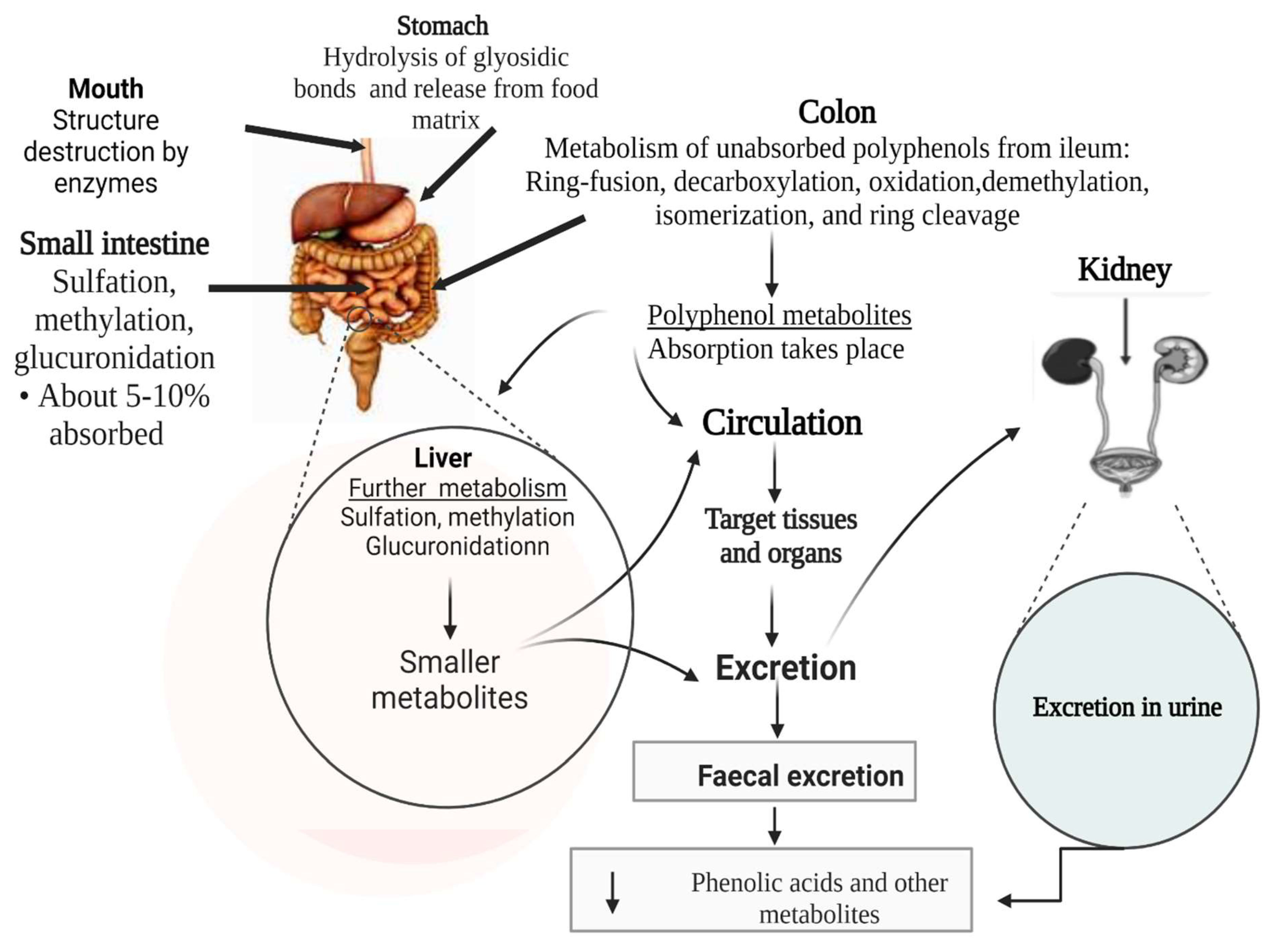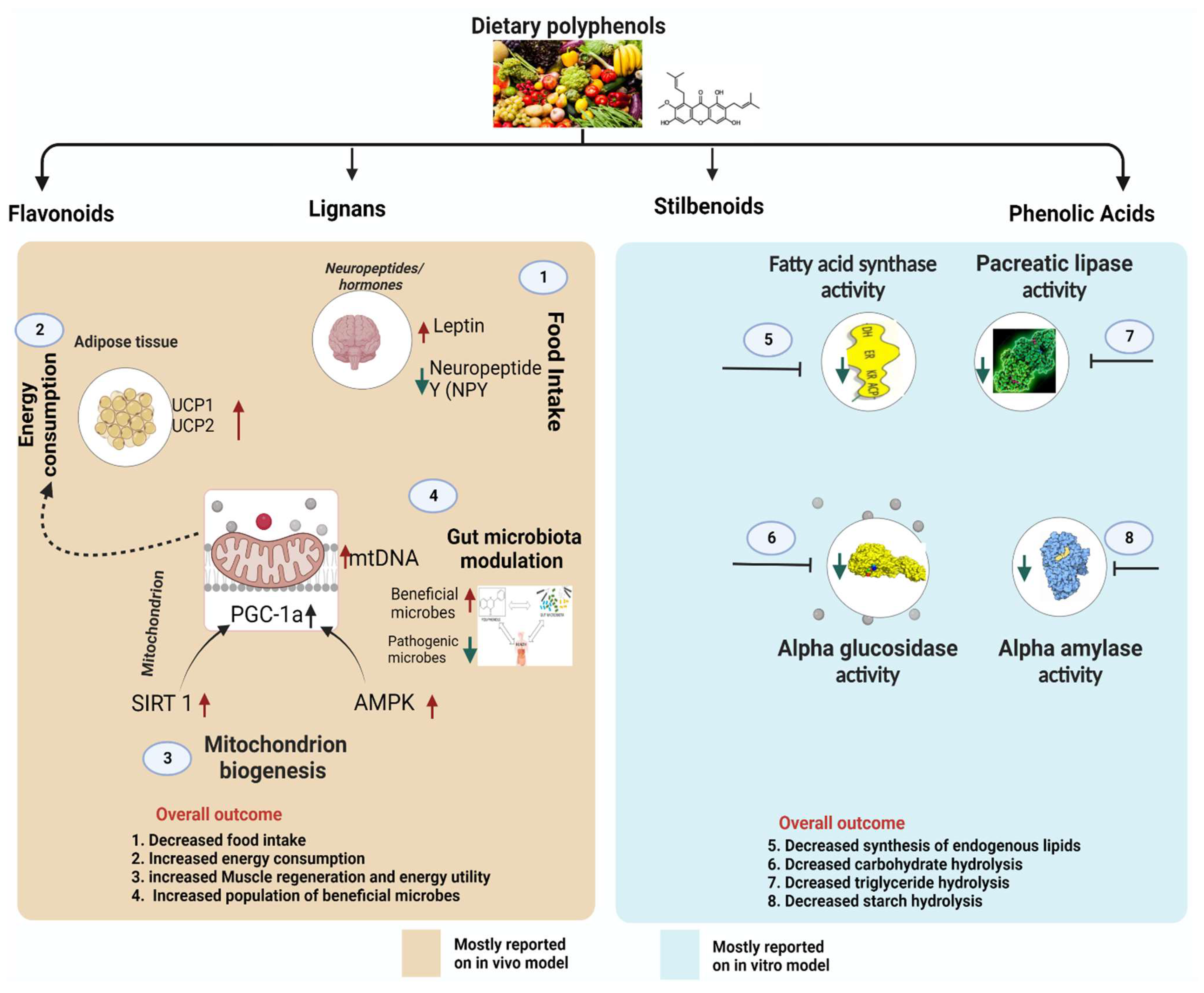
| Version | Summary | Created by | Modification | Content Size | Created at | Operation |
|---|---|---|---|---|---|---|
| 1 | Deog-Hwan Oh | -- | 1708 | 2023-02-15 05:41:53 | | | |
| 2 | Peter Tang | + 3 word(s) | 1711 | 2023-02-15 07:00:29 | | |
Video Upload Options
Polyphenols are vital phytonutrients of plant origin that can be incorporated as functional ingredients in foods to offer an effective natural therapy against obesity. There have been efforts to discover alternative obesity treatments from dietary polyphenols.
1. Introduction

2. Flavonoid-Type Phenolic Compounds
3. Non-Flavonoid-Type Phenolic Compounds in Foods
4. Integrating Polyphenols as Bioactive Ingredients in Foods
5. Metabolism by Gut Microbes and Post Absorption Fate of Polyphenols
Polyphenol metabolism along the gut involves a series of stages. Figure 2 offers a detailed summary of the polyphenol metabolic process along the human gut.

Figure 2. Metabolism fate of polyphenols by the human gut microbiota. In the mouth, the structure of polyphenols is broken down by enzymes, releasing the compounds from the food matrix. In the stomach, the polymeric polyphenols and their glycosidic bonds are hydrolyzed as the digestion process continues. Once they reach the small intestine, polyphenols undergo enzymatic deglycosylation, and absorption of some digested compounds (5-10%) takes place. The absorbed phenolic compounds enter into the circulation and reach the liver where they are metabolized further into smaller metabolites. At the same time, in the large intestine, gut microbiota hydrolyses unabsorbed polyphenols, making them available for absorption into the bloodstream. Eventually, polyphenols metabolites are released from the body either through fecal matters or urine excretion.
6. Mode of Action against obesity
The mechanisms through which polyphenols can inhibit obesity include digestive enzymes (mainly alpha-glucosidase, pancreatic lipase, fatty acid synthase, and alpha-amylase), stimulating energy expenditure, suppressing appetite, regulating lipid synthesis, and modulation of gut microbiota (Figure 3). These mechanisms may occur individually or in certain combinations.

Figure 3. Mode of action for antiobesity of polyphenols. ↑, Up-regulation; ↓, down-regulation
7. Conclusion
Polyphenols are important phytonutrients in the diet. They offer the opportunity to improve nutrition by developing novel foods targeting different kinds of diseases. Emerging evidence from in vitro, in vivo, and clinical al studies suggests that dietary polyphenols play an important role in the prevention of metabolic diseases, including obesity, diabetes, and cardiovascular diseases. However, although these beneficial health claims are supported by experimental data, their effect on metabolic diseases still requires further investigation. The anti-obesity mechanisms of polyphenols have been explained by their potential to inhibit obesity-related digestive enzymes, modulate neurohormones/peptides involved in food intake, and their ability to improve the growth of beneficial gut microbes while inhibiting the proliferation of pathogenic ones. Thus, the ever-growing interest and public awareness surrounding the potential benefits of polyphenols, in addition to their widespread availability and accessibility through nutritional supplements and fortified foods, provoke the need for more research to unveil the benefits of these compounds.
References
- Sergent, T.; Vanderstraeten, J.; Winand, J.; Beguin, P.; Schneider, Y.-J. Phenolic compounds and plant extracts as potential natural anti-obesity substances. Food Chem. 2012, 135, 68–73.
- Boccellino, M.; D’Angelo, S. Anti-obesity effects of polyphenol intake: Current status and future possibilities. Int. J. Mol. Sci. 2020, 21, 5642.
- WHO. Adolescent Obesity and Related Behaviours: Trends and Inequalities in the WHO European Region, 2002–2014; WHO: Geneva, Switzerland, 2017.
- Singh, M.; Thrimawithana, T.; Shukla, R.; Adhikari, B. Managing obesity through natural polyphenols: A review. Future Foods 2020, 1, 100002.
- Ozdal, T.; Sela, D.A.; Xiao, J.; Boyacioglu, D.; Chen, F.; Capanoglu, E. The reciprocal interactions between polyphenols and gut microbiota and effects on bioaccessibility. Nutrients 2016, 8, 78.
- Akhlaghi, M.; Ghobadi, S.; Hosseini, M.M.; Gholami, Z.; Mohammadian, F. Flavanols are potential anti-obesity agents, a systematic review and meta-analysis of controlled clinical trials. Nutr. Metab. Cardiovasc. Dis. 2018, 28, 675–690.
- Wu, S.; Tian, L. A new flavone glucoside together with known ellagitannins and flavones with anti-diabetic and anti-obesity activities from the flowers of pomegranate (Punica granatum). Nat. Prod. Res. 2019, 33, 252–257.
- Corrêa, T.A.F.; Rogero, M.M.; Hassimotto, N.M.A.; Lajolo, F.M. The two-way polyphenols-microbiota interactions and their effects on obesity and related metabolic diseases. Front. Nutr. 2019, 6, 188.
- Otton, R.; Bolin, A.P.; Ferreira, L.T.; Marinovic, M.P.; Rocha, A.L.S.; Mori, M.A. Polyphenol-rich green tea extract improves adipose tissue metabolism by down-regulating miR-335 expression and mitigating insulin resistance and inflammation. J. Nutr. Biochem. 2018, 57, 170–179.
- Yamakoshi, J.; Saito, M.; Kataoka, S.; Kikuchi, M. Safety evaluation of proanthocyanidin-rich extract from grape seeds. Food Chem. Toxicol. 2002, 40, 599–607.
- Lee, H.; Jeong, J.H.; Ryu, J.-H. Lignan from Alnus japonica inhibits adipocyte differentiation via cell cycle and FOXO1 regulation. Molecules 2020, 25, 3346.
- Mir, S.A.; Shah, M.A.; Ganai, S.A.; Ahmad, T.; Gani, M. Understanding the role of active components from plant sources in obesity management. J. Saudi Soc. Agric. Sci. 2019, 18, 168–176.
- Adaim, A.; Zhang, J.; Lauren, D.; Stanley, R.; Skinner, M. Polyphenols and health: Using cell-based assays to aid in the development of new functional foods. Asia Pac. J. Clin. Nutr. 2005, 14, S106.
- Ravi, A.; Perera, C.; Quek, S.; Sun-Waterhouse, D. Physico-chemical properties of bread dough fortified with fruit fibers and phenolic antioxidants. In Proceedings of the Oral Presentation at the 2009 Institute of Food Technologists (IFT) Annual Meeting & Food Expo, Anaheim, CA, USA, 6–9 June 2009.
- Bora, A.F.M.; Ma, S.; Li, X.; Liu, L. Application of microencapsulation for the safe delivery of green tea polyphenols in food systems: Review and recent advances. Food Res. Int. 2018, 105, 241–249.
- Sun-Waterhouse, D. The development of fruit-based functional foods targeting the health and wellness market: A review. Int. J. Food Sci. Technol. 2011, 46, 899–920.
- Kiss, A.; Takács, K.; Nagy, A.; Nagy-Gasztonyi, M.; Cserhalmi, Z.; Naár, Z.; Halasi, T.; Csáki, J.; Némedi, E. In vivo and in vitro model studies on noodles prepared with antioxidant-rich pseudocereals. J. Food Meas. Charact. 2019, 13, 2696–2704.
- Mayneris-Perxachs, J.; Alcaide-Hidalgo, J.M.; de la Hera, E.; del Bas, J.M.; Arola, L.; Caimari, A. Supplementation with biscuits enriched with hesperidin and naringenin is associated with an improvement of the Metabolic Syndrome induced by a cafeteria diet in rats. J. Funct. Foods 2019, 61, 103504.




